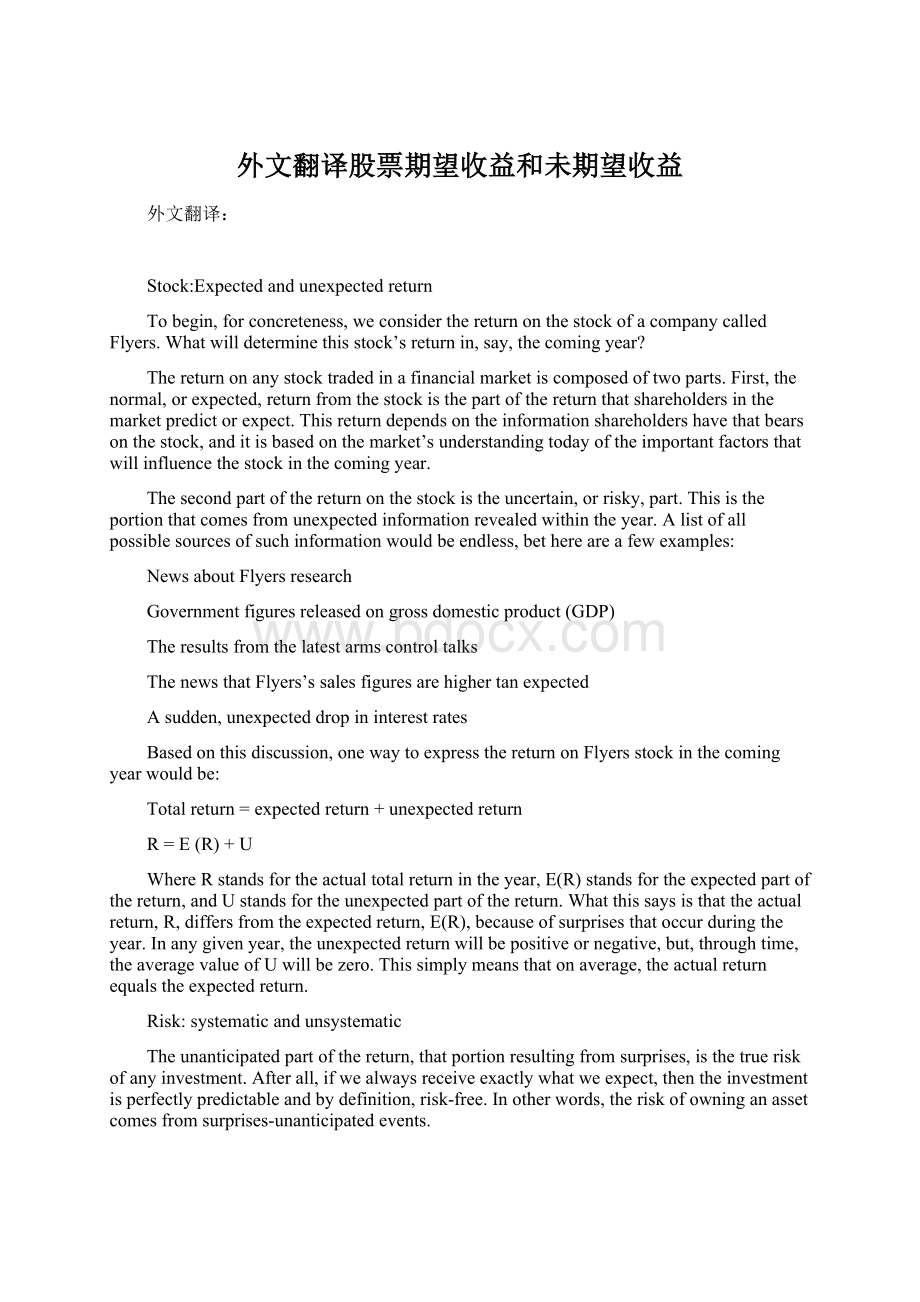外文翻译股票期望收益和未期望收益Word文档下载推荐.docx
《外文翻译股票期望收益和未期望收益Word文档下载推荐.docx》由会员分享,可在线阅读,更多相关《外文翻译股票期望收益和未期望收益Word文档下载推荐.docx(11页珍藏版)》请在冰豆网上搜索。

Tobegin,forconcreteness,weconsiderthereturnonthestockofacompanycalledFlyers.Whatwilldeterminethisstock’sreturnin,say,thecomingyear?
Thereturnonanystocktradedinafinancialmarketiscomposedoftwoparts.First,thenormal,orexpected,returnfromthestockisthepartofthereturnthatshareholdersinthemarketpredictorexpect.Thisreturndependsontheinformationshareholdershavethatbearsonthestock,anditisbasedonthemarket’sunderstandingtodayoftheimportantfactorsthatwillinfluencethestockinthecomingyear.
Thesecondpartofthereturnonthestockistheuncertain,orrisky,part.Thisistheportionthatcomesfromunexpectedinformationrevealedwithintheyear.Alistofallpossiblesourcesofsuchinformationwouldbeendless,bethereareafewexamples:
NewsaboutFlyersresearch
Governmentfiguresreleasedongrossdomesticproduct(GDP)
Theresultsfromthelatestarmscontroltalks
ThenewsthatFlyers’ssalesfiguresarehighertanexpected
Asudden,unexpecteddropininterestrates
Basedonthisdiscussion,onewaytoexpressthereturnonFlyersstockinthecomingyearwouldbe:
Totalreturn=expectedreturn+unexpectedreturn
R=E(R)+U
WhereRstandsfortheactualtotalreturnintheyear,E(R)standsfortheexpectedpartofthereturn,andUstandsfortheunexpectedpartofthereturn.Whatthissaysisthattheactualreturn,R,differsfromtheexpectedreturn,E(R),becauseofsurprisesthatoccurduringtheyear.Inanygivenyear,theunexpectedreturnwillbepositiveornegative,but,throughtime,theaveragevalueofUwillbezero.Thissimplymeansthatonaverage,theactualreturnequalstheexpectedreturn.
Risk:
systematicandunsystematic
Theunanticipatedpartofthereturn,thatportionresultingfromsurprises,isthetrueriskofanyinvestment.Afterall,ifwealwaysreceiveexactlywhatweexpect,thentheinvestmentisperfectlypredictableandbydefinition,risk-free.Inotherwords,theriskofowninganassetcomesfromsurprises-unanticipatedevents.
Thereareimportantdifferences,though,amongvarioussourcesofrisk.Lookbackatourpreviouslistofnewsstories.SomeofthesestoriesaredirectedspecificallyatFlyers,andsomearemoregeneral.WhichofthenewsitemsareofspecificimportancetoFlyers?
AnnouncementsaboutinterestratesorGDPareclearlyimportantfornearlyallcompanies,whereasthenewsaboutFlyers’spresident,itsresearch,oritssalesisofspecificinteresttoFlyers.Wewilldistinguishbetweenthesetwotypesofevents,because,asweshallsee,theyhaveverydifferentimplications.
Systematicandunsystematicrisk
Thefirsttypeofsurprise,theonethataffectsalargenumberofassets,wewilllabelsystematicrisk.Asystematicriskisonethatinfluencesalargenumberofassets,eachtoagreateroflesserextent.Becausesystematicriskshavemarketwideeffects,theyaresometimescalledmarketrisks.
Thesecondtypeofsurprisewewillcallunsystematicrisk.Anunsystematicriskisonethataffectsasingleassetorasmallgroupofassets.Becausetheserisksareuniquetoindividualcompaniesorassets,theyaresometimescalleduniqueorassetspecificrisks.Wewillusethesetermsinterchangeably.
Aswehaveseen,uncertaintiesaboutgeneraleconomicconditions,suchasGDP,interestrates,orinflation,areexamplesofsystematicrisks.Theseconditionsaffectnearlyallcompaniestosomedegree.Anunanticipatedincrease,orsurprise,ininflation,forexample,affectswagesandthecostsofsuppliesthatcompaniesbuy,itaffectsthevalueoftheassetsthatcompaniesown,anditaffectsthepricesatwhichcompaniesselltheirproducts.Forcessuchasthese,towhichallcompaniesaresusceptible,aretheessenceofsystematicrisk.
Incontrast,theannouncementofanoilstrikebyacompanywillprimarilyaffectthatcompanyand,perhaps,afewothers(suchasprimarycompetitorsandsuppliers).Itisunlikelytohavemuchofaneffectontheworldoilmarket,however,orontheaffairsofcompaniesnotintheoilbusiness,sothisisanunsystematicevent.
Systematicandunsystematiccomponentsofreturn
Thedistinctionbetweenasystematicriskandanunsystematicriskisneverreallyasexactaswemakeitouttobe.Eventhemostnarrowandpeculiarbitofnewsaboutacompanyripplesthroughtheeconomy.Thisistruebecauseeveryenterprise,nomatterhowtiny,isapartofeconomy.It’slikethetaleofakingdomthatwaslostbecauseonehorselostashoe.Thisismostlyhairsplitting,however.Somerisksareclearlymuchmoregeneralthanothers.We’llseesomeevidenceonthispointinjustamoment.
Thedistinctionbetweenthetypesofriskallowsustobreakdownthesurpriseportion,U,ofthereturnontheFlyersstockintotwoparts.Earlier,wehadtheactualreturnbrokendownintoitsexpectedandsurprisecomponents:
WenowrecognizethatthetotalsurprisecomponentforFlyers,U,hasasystematicandanunsystematiccomponent,so:
R=E(R)+systematicportion+unsystematicportion
Systematicrisksareoftencalledmarketrisksbecausetheyaffectmostassetsinthemarkettosomedegree.
Theimportantthingaboutthewaywehavebrokendownthetotalsurprise,U,isthattheunsystematicportionismoreorlessuniquetoFlyers.Forthisreason,itisunrelatedtotheunsystematicportionofreturnonmostotherassets.Toseewhythisisimportant,weneedtoreturntothesubjectofportfoliorisk.
Diversificationandportfoliorisk
We’veseenearlierthatportfolioriskscan,inprinciple,bequitedifferentfromtherisksoftheassetsthatmakeuptheportfolio.Wenowlookmorecloselyattheriskinessofanindividualassetversustheriskofaportfolioofmanydifferentassets.WewillonceagainexaminesomemarkethistorytogetanideaofwhathappenswithactualinvestmentsinU.Scapitalmarkets.
Theeffectofdiversification:
anotherlessonfrommarkethistory
Inourpreviouschapter,wesawthatthestandarddeviationoftheannualreturnonaportfolioof500largecommonstockshashistoricallybeenabout20percentperyear.Doesthismeanthatthestandarddeviationoftheannualreturnonatypicalstockinthatgroupof500isabout20percent?
Asyoumightsuspectbynow,theanswerisno.thisinanextremelyimportantobservation.
Toallowexaminationoftherelationshipbetweenportfoliosizeandportfoliorisk,Table11.4illustratestypicalaverageannualstandarddeviationforequallyweightedportfoliothatcontaindifferentnumbersofrandomlyselectedNYSEsecurities,
Incolumn2oftable11.4,weseethatthestandarddeviationfora“portfolio”ofonesecurityisabout49percent.WhatthismeansisthatifyourandomlyselectedasingleNYSEstockandputallyourmoneyintoit,yourstandarddeviationofreturnwouldtypicallybeasubstantial49percentperyear.Ifyouweretorandomlyselecttwostocksandinvesthalfyourmoneyineach,yourstandarddeviationwouldbeabout37percentonaverage,andsoon.
Theimportantthingtonoticeintable11.4isthatthestandarddeviationdeclinesasthenumberofsecuritiesisincreased.Bythetimewehave100randomlychosenstocks,theportfolio’sstandarddeviationhasdeclinedbyabout60percent,from49percenttoabout20percent.With500securities,thestandarddeviationis19.27percent,similartothe20percentwesawinourpreviouschapterforthelargecommonstockportfolio.Thesmalldifferenceexistsbecausetheportfoliosecuritiesandtimeperiodsexaminedarenotidentical.
Theprincipleofdiversification
Figure11.9illustratesthepointwe’vebeendiscussing.Whatwehaveplottedisthestandarddeviationofreturnversusthenumberofstocksintheportfolio.Noticeinfigure11.9thatthebenefitintermsofriskreductionfromaddingsecuritiesdropsoffasweaddmore.Bythetimewehave10securities,mostoftheeffectisalreadyrealized,andbythetimewegetto30orso,thereisverylittleremainingbenefit.
Figure11.9illustratestwokeypoints.First,someoftheriskinessassociatedwithindividualassetscanbeeliminatedbyformingportfolio.Theprocessofspreadinganinvestmentacrossassets(andtherebyformingaportfolio)iscalleddiversification.Theprincipleofdiversificationtellsusthatspreadinganinvestmentacrossmanyassetswilleliminatesomeoftherisk.Theblueshadedareainfigure11.9,labeled“diversifiablerisk”isthepartthatcanbeeliminatedbydiversification.
Thesecondpointisequallyimportant.Thereisaminimumlevelofriskthatcannotbeeliminatedsimplybydiversifying.Thisminimumlevelislabeled“nondiversifiablerisk”infigure11.9.Takentogether,thesetwopointsareanotherimportantlessonfromcapitalmarkethistory:
diversificationreducesrisk,butonlyuptoapoint.Putanotherway,someriskisdiversifiableandsomeisnot.
Togivearecentexampleoftheimpactofdiversification,theDowJonesIndustrialAverage(DJIA),whichisawidelyfollowedstockmarketindexof30large,well-knownU.Sstocks,wasupabout25percentin2003.Aswesawinourpreviouschapter,thisrepresentsaprettygoodyearforaportfoliooflarge-capstocks.ThebiggestindividualgainersfortheyearwereIntel(up107percent),Caterpillar(up86percent),andAlcoa(up71percent).Butnotall30stockswereup:
thelosersincludedEastmanKodak(down24percent.)AT&
T(down19percent),andMerck(down11percent).
Incontrastto2003,consider2002whentheDJIAwasdownabout17percent,afairlybadyear.ThebiglosersinthisyearwereHomeDepot(down52percent),andIntel(down50percent).Workingtooffsetthesel